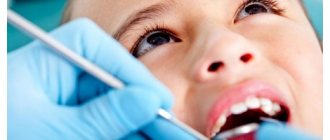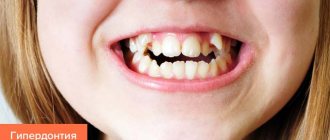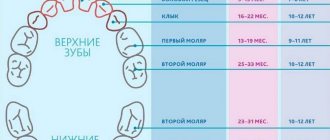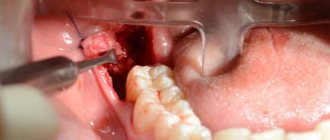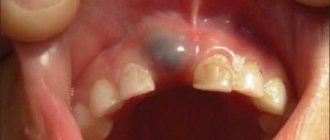A baby at the age of four months is not yet able to communicate what is bothering him, where it hurts, what factors cause discomfort. Typically, the first baby teeth begin to emerge at six months, but it is not uncommon for the middle incisors to appear in four-month-old babies. It is very important to recognize the signs of teething in order to help your baby get through this period as easily as possible.
Signs of teething in a 4 month old baby
On a note! Early teething is not considered a pathology. The age of 4-7 months is considered the norm for the appearance of the first primary incisors.
Teething Chart
Teething at three months of age: normal or pathological
When the baby is very small, parents often associate his anxiety, fever and the appearance of other undesirable symptoms with illness, but not with the appearance of his first teeth. After all, the average time for teething is within 6–8 months. But pediatric dentistry knows many cases when the process begins earlier than this time frame. Therefore, parents need to prepare to help their child at any time.
How to relieve painful sensations
During this period, the baby's growing body undergoes important changes, and the support of adults and their care can significantly alleviate this condition. Firstly, take your child in your arms more often so that he feels supported; tactile contact will further calm and distract him. Secondly, make sure that he drinks the required amount of water - usually the baby begins to refuse the bottle, just feed him from a spoon.
You can put the baby to your chest to calm him down, do not forget about massaging the gums, which is best done using a special attachment on your finger.
What to use
If basic techniques do not save the situation, you should resort to auxiliary options. If the pain is very intense, try local anesthesia. For this purpose, special gels containing benzocaine/lidocaine are suitable, which are applied directly to the gums several times a day. They have a short-term effect and are safe for a small organism, but it is still recommended to consult a specialist first.
Preparations based on ibuprofen or paracetamol are good for relieving fever. You can take it several times a day, the drugs fight high fever and partially relieve pain.
But you shouldn’t ignore folk recipes either; it will be useful to make infusions of mint, chamomile, lavender, and sage. The resulting substance is impregnated with a cotton pad, which must be used to wipe soft tissues. You can also replace the infusion with a soda solution; this will require a glass of boiled water and 1 teaspoon of baking soda.
Additional Methods
At an early stage of life, it is especially important to support the child, since any load on the small body is felt very acutely. A special reaction to teething requires a special drug, for example, Dentokind copes well with all symptoms - it provides analgesia, an anti-inflammatory, calming effect, and sleep stabilization.
To satisfy your child’s craving to put various objects in his mouth and at the same time alleviate his condition, buy a special rubber ring, which is placed in the freezer for a short time for cooling and given to the child.
Perhaps the baby will not like such a ring, then watch what he likes. The main thing is that the objects do not have sharp corners and cannot damage the gums, for example, it could be a bagel or a bread crust.
Try to distract your child as much as possible, switch his attention to a game or an interesting cartoon. Daily walks will also help if you don’t have a fever and your condition allows it.
Category Children Published by Mister stomatolog
Teeth cutting at 3 months: what parents need to know
Noticing changes in behavior and deterioration in the baby’s well-being, parents wonder whether teething can occur at 3 months. Although such timing is not typical, it is worth knowing that the appearance of incisors at this age is possible. By the way, there are rare cases when a child is already born with teeth.
Deviations in both directions from the average time frame are considered normal. Each child's body is individual. In addition, various factors influence the timing of eruption:
- during pregnancy - the milk bite is formed in the womb at 7–8 weeks;
- mother's diet - consumption of fermented milk products in large quantities by the pregnant woman promotes rapid teething;
- additional intake of mineral complexes - in particular vitamin D and C;
- genetic predisposition to early teething;
- climatic conditions - the process of teething begins earlier among residents of the south.
In some cases, early tooth growth may indicate pathology, in particular endocrine system disorders. But it is believed that it is not the timing that speaks about the healthy development of the baby. It matters what kind of teeth come in. It is important that the order in which they appear is observed. The central teeth grow first from below, followed by their antagonists from above. Then the lateral incisors appear, followed by the canines (first the upper, then the lower). The last to be cut are the molars on the lower and upper jaws.
Teething sequence
Of course, we will talk about the standards according to which the optimal time and order of appearance of the first molars is determined. But don’t be upset if the baby’s personal schedule is behind or in a hurry in relation to this “schedule”. The discrepancy may well reach six months in one direction or the other, so if teeth are already making themselves felt at 3 (three) months, this should not be a cause for concern.
There is the following scheme for the eruption of primary molars:
- 5–7 months - a pair of lower frontal incisors;
- 8–10 months - upper front incisors;
- 10–12 months - a pair of lateral incisors on the upper jaw;
- 11–14 months - lower lateral incisors;
- 12–15 months - first the upper first molars, and then the lower ones;
- 16–23 months - upper, then lower canines;
- 24–30 months - upper, lower second molars.
If the frontal incisors emerge at three months, this is normal, but make sure that the first pair is formed first, and only then, for example, one of the lateral incisors. It is important to immediately rule out pathology in order to take the necessary measures in time.
Teething symptoms
How not to confuse the process of the appearance of the first teeth with a certain disease? The following symptoms may indicate teething:
- Swelling of the gums, looseness, redness. Sometimes the tooth is visible through the tissue. In some cases, hematomas form.
- Irritability. The baby may be bothered by pain and itching, so he becomes restless and whiny. The child's sleep is disturbed due to discomfort.
- Active sucking. When the baby actively sucks on the breast or pacifier, in this way he tries to relieve the discomfort from the pressure of the tooth on the gum from the inside. In some cases, the baby, on the contrary, loses appetite.
- Increased body temperature (usually up to 37.5°). In most cases, this is a short-term symptom. A higher temperature indicates a bacterial infection.
- Increased salivation. Such a symptom may not only indicate teething. At 3 months this is a physiological process. Therefore, it is worth taking other signs into account. When the first teeth appear, drooling may cause a rash around the mouth. Since at the age of three months the baby is often in a lying position, saliva flows down the walls of the throat. It gets into the nasal passages, which provokes rhinitis. When mucus gets into the throat, a cough also occurs, which most often occurs during sleep.
Such symptoms do not occur all at once, but still cause concern for parents. They worry about teething at such an early age, and then they have to deal with the deterioration of the baby’s well-being.
Since many of the symptoms occur with infectious diseases, it is better to show the child to the doctor. You should not hesitate to visit a specialist if the baby is lethargic, has a high temperature that does not fall, rashes appear on the oral mucosa, or vomiting occurs. The last symptom does not always indicate a complication. It can also occur due to mucus getting into the stomach.
When an infection occurs, the child begins to develop diarrhea. This condition requires careful monitoring, since frequent and loose stools can cause dehydration.
Help a child
When negative symptoms develop, which bring a lot of discomfort to the child, lack of appetite and sleep, therapy is recommended. It should be gentle so as not to harm the body at an early age.
Elimination of elevated temperature
If a child’s body temperature rises and remains at 38°C or higher, give one of the following medications:
- Nurofen;
- Cefekon D;
- Children's Paracetamol;
- Panadol.
In total, there are 2 active ingredients with different properties:
- Paracetamol
. The volume of active substance is calculated based on the child’s body weight. The maximum daily dose is 60 mg per 1 kg of body weight. Take before meals for a quick effect. If you need to calculate a single dose, calculate 15 mg per kilogram of body weight. After taking an antipyretic drug, the next dose can be taken no earlier than 4 hours later. Young patients are given drugs in the form of syrups. They have a sweet taste, so the child swallows them without problems. If the body temperature is too high, it is recommended to give suppositories. The active substance is quickly absorbed through the intestinal mucosa, so the temperature drops faster. - Ibuprofen
. This is a more potent substance, so 6-8 hours should pass between doses. Only 3 doses are allowed to be given in 1 day. Calculation is made for 1 dosage from the ratio of 10 mg of the drug per kilogram of the child’s body weight. If you need to calculate the daily dose, use a ratio of 30 mg of the drug per kilogram of body weight.
If side effects occur, you must stop taking the drug. Any type of negative reaction that could lead to a deterioration in the baby’s well-being is not acceptable.
Antipyretic drugs are recommended to be used after a general examination of the baby and anamnesis. This is what the pediatrician does.
Treatment of a runny nose
For the treatment of a runny nose, the following gentle remedies are recommended, which are allowed for children from birth:
- Derinat;
- Nazivin baby;
- Aqua Maris.
Nasal drops are used only as a last resort, as they are vasoconstrictor drugs. The maximum intake should be no more than 5 days.
Pain in gums
The table shows the optimal drugs for eliminating pain in the gums.
| A drug | Characteristic |
| Kalgel | Apply a small amount of gel to the gums. Application is carried out for no more than 6 days. Allowed to be applied 4-5 times a day |
| Kamistad baby | You can use a cotton swab or your fingers to apply the product. Reception is carried out no more than 3 times a day |
| Holisal | Soft tissues are pre-wiped with a cotton pad and rubbed in 3 times a day. |
To make teething easier, special toys are provided. They are called teethers. It is recommended to pre-treat them with boiling water to prevent the spread of bacterial microflora.
During teething it is not recommended to wean. This will be very stressful for the child. Breastfeeding helps him calm down.
How to make your baby feel better when teething
We have already dealt with the question of whether teeth can erupt at the age of three months. But when this process begins, parents are faced with another dilemma - what to do to alleviate the child’s condition. In such a stressful situation, he needs physical and psycho-emotional contact - carry the baby in your arms, rock him, talk to him gently. This will help relieve nervousness. To eliminate other unwanted symptoms, the following methods are used:
- Gum massage. Do it with the tip of your finger, after washing your hands. To avoid injuring the child, you should also trim your nails. There are also silicone finger pads with bristles or pimples on sale. To determine the intensity of the massaging movements, you need to monitor the baby's reaction.
- Cold. Since regular teethers are not suitable for a 3-month-old baby, other alternative methods are used - cool the pacifier or apply a gauze cloth soaked in cold boiled water.
- Pharmacy products. If you notice that your baby's incisors are starting to come out, you should consult with your pediatrician about which gel or ointment to choose. Not all drugs are suitable for the youngest, but there is still a choice. For example, "Kamistad" or "Kalgel" are safe for three-month-old children.
- Antipyretic. Preparations based on paracetamol and ibuprofen help. In addition to normalizing body temperature, they relieve pain. Babies are often given candles, for example, Efferalgan.
You need to be careful to notice which method best helps your baby. During the period when teeth erupt, it also needs careful care. To avoid infection of the gums, you need to keep his pacifier clean and monitor breast hygiene. Saliva should be wiped away with clean napkins, without making any effort, so as not to irritate delicate skin. After this, you can apply baby cream with light massaging movements. Walking in the fresh air in places where there are not large crowds of people will be useful for the baby.
Picture of the appearance of the first molars
Remember, the main thing is that the first teeth erupt before one year. At the same time, do not expect that the process itself will proceed according to the textbook - some children tolerate it easily and almost unnoticeably, others experience intense discomfort.
Sometimes teeth at 3 (three) months begin to manifest themselves very seriously, for example, tissue soreness, refusal to eat and high fever. A runny nose and vomiting are possible as a result of copious discharge.
Regarding the order of eruption and what symptoms appear and how easy or difficult the process itself is, the genetic factor is often of great importance here. Ask how everything went for you, and you can compare the picture of manifestations and draw certain conclusions for the future.
How long does it take for first molars to erupt?
When a child has already lost several teeth, parents have an idea of the duration of the process, but when the very first one appears, it is still difficult to talk about it. The first symptoms begin to appear about a month before actual eruption. For some the duration is a month, for others it is two weeks, everything is very individual.
This can also be used to judge when the baby will have all his milk teeth (20 molars in total). Early teething means that the baby will most likely acquire a whole set of hard formations by the age of two. In such children, new molars appear almost every month and are not accompanied by serious difficulties. For others, this same set is formed only by the age of 3.5, which is also normal.
Ways to alleviate the condition
The formation of a bite is often accompanied by an increase in temperature. Therefore, parents should always have antipyretic drugs in their medicine cabinet (Panadol, Nurofen, Ibuklin). They not only reduce the temperature, but also relieve pain associated with tooth growth.
The love and attention of parents will allow the child to cope with the problem. The baby should be put to the breast and picked up as often as possible. Special teethers with gel will help satisfy your baby’s desire to scratch his teeth.
You need to choose small devices so that the child can comfortably hold it in his hand.
Pediatricians advise cooling teethers with cold water before giving them to a child. Instead of toys, you can give your baby chilled pieces of apple or carrot. At the same time, parents should carefully monitor that the baby does not bite off the product and does not choke on it. In parallel with this, local anesthetics can be used.
On the pharmacological market there are many drugs in the form of a gel that relieve pain during the appearance of teeth - Kalgel, Kamistad, Cholisal. Additionally, the gels have an anti-inflammatory effect, which also alleviates the child’s condition. The analgesic effect occurs 2-3 minutes after using the drug.
Factors affecting tooth growth
The speed of formation of a mixed bite depends on several circumstances:
- baby's genotype;
- performance of the thyroid gland;
- gender;
- severe infectious and viral diseases suffered in the past;
- duration of natural feeding;
- the presence of congenital diseases.
You also need to monitor the period of eruption of molars. They should come out to the surface of the gums only after the milk unit falls out. Otherwise, a mandatory visit to the dentist will be required. Early loss of milk elements is also undesirable, as this negatively affects the proportions of the baby’s jaw and his bite in the future.
Reasons for the atypical timing of the eruption of elements
Only a dentist can accurately determine the causes of abnormal teething in children. However, there are several common violations that lead to the problem:
- improper metabolism;
- lack of calcium in the body;
- disturbances in the functioning of the endocrine system;
- gastrointestinal pathologies;
- incorrect direction of the tooth axis.
Anomalies of the dentition can be associated not only with the timing of the appearance of elements, but also with the color, location, and size of the units in the row. If a child is already born with teeth, they are usually removed. Such situations are diagnosed quite rarely, and they indicate intrauterine disorders in the baby.

